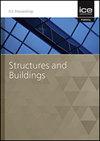Kath Kuni architecture: field investigations and material characterisation
IF 1.4
4区 工程技术
Q3 CONSTRUCTION & BUILDING TECHNOLOGY
Proceedings of the Institution of Civil Engineers-Structures and Buildings
Pub Date : 2023-05-19
DOI:10.1680/jstbu.22.00080
引用次数: 0
Abstract
This study presents the results of an extensive investigation carried out to better understand the seismic resilient features of Kath-Kuni structures that is mainly timber-laced dry masonry construction prevalent in the Himachal Pradesh region of India. The research comprised field reconnaissance surveys through rapid visual screening to understand the structural configuration. Thereafter, laboratory testing was conducted to evaluate the mechanical properties, joint characteristics, and interfacial resistance of timber and stones. Results from the field survey highlighted that the symmetrical geometry, the use of lintels above openings, and the corner interlocking were the major contributors to increase the seismic resilience of the buildings. Laboratory testing conducted on wooded joints present in the walls namely dowel and double-dovetail joints indicated the importance of connection conditions in increasing the shearing capacity. Besides, the shearing capacity was also dependent on the overburden pressure indicating the least capacity of connection at the top portion of the wall and the highest capacity at the bottom portion of the wall. The interface of timber and stones contributed to further increasing the shearing capacity of the walls. The output of this research is the first insight into the mechanical behaviour of joints of the Kath-Kuni structure.Kath Kuni建筑:实地调查和材料表征
本研究展示了一项广泛调查的结果,该调查是为了更好地了解印度喜马偕尔邦地区普遍存在的kathi - kuni结构的抗震弹性特征。kathi - kuni结构主要是木纹干砌体结构。该研究包括通过快速视觉筛选来了解结构结构的实地侦察调查。随后,进行了室内测试,以评估木材和石材的力学性能、接缝特性和界面阻力。现场调查的结果强调,对称的几何形状,在开口上方使用过梁,以及角落的联锁是增加建筑物抗震能力的主要因素。对墙体中存在的木节点,即销钉和双燕尾节点进行的实验室测试表明,连接条件对提高剪切能力的重要性。抗剪能力也与覆盖层压力有关,表明墙体顶部连接能力最小,底部连接能力最大。木材和石材的界面进一步提高了墙体的抗剪能力。这项研究的成果是对kathi - kuni结构关节力学行为的第一次洞察。
本文章由计算机程序翻译,如有差异,请以英文原文为准。
求助全文
约1分钟内获得全文
求助全文
来源期刊
CiteScore
3.40
自引率
6.20%
发文量
61
审稿时长
12 months
期刊介绍:
Structures and Buildings publishes peer-reviewed papers on the design and construction of civil engineering structures and the applied research associated with such activities. Topics include the design, strength, durability and behaviour of structural components and systems.
Topics covered: energy conservation, people movement within and around buildings, strength and durability of steel and concrete structural components, and the behaviour of building and bridge components and systems

 求助内容:
求助内容: 应助结果提醒方式:
应助结果提醒方式:


